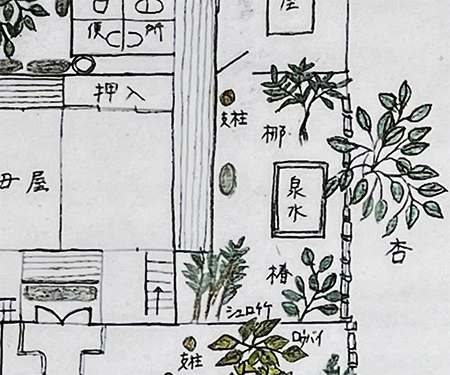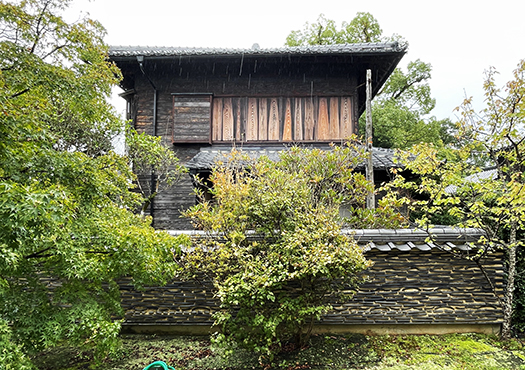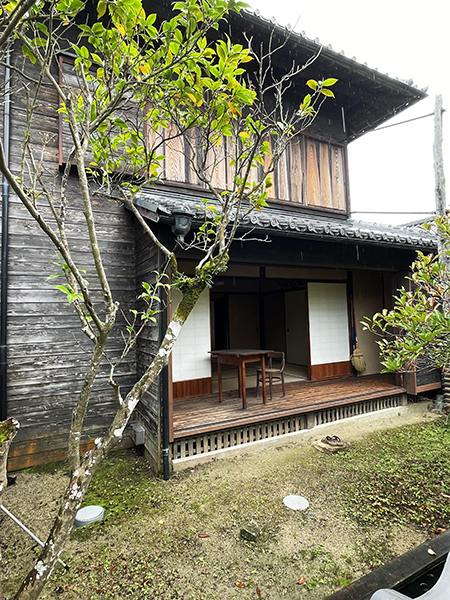


北海道の住宅関係人であるわたしからすると、本州以南地域の住宅文化における「庭園」の占めている要素・重量感について、やや疎外感を持って見ている部分がある。やはり北国ではどんなに端正な庭園を作っても、通年それをガラス建具による結界もなく、いわば肌身で感受するたのしみはあり得ない。冬にはそれらの庭木群がどれほどの積雪荷重にさらされ、それによる矮化も覚悟せざるを得ないことから、家の中と庭とは異世界という感覚が強まって行かざるを得ない。日本人のこころの原風景に刷り込まれているようなサザエさんの家的な空間、縁側があってそこから庭木を愛でるような家は成立しがたいのだ。
そういったことに鋭敏であらざるを得ないネイティブ北方体験をし続ける人間。そういう人間からすると、この南方熊楠邸は、まったく想像を絶するような温暖・蒸暑地域のさまざまな植生こそが「主体」となった、いわば植物が主人でそこに学者としてその観察人が最大の興味を持って日々を共生している、と受け取れた。
ただ、いわば風流数寄という趣味生活的なものごころから、この南方熊楠邸は成り立ってはいないこともあきらかだと感じられた。まことに理知的な、ひとつひとつの植栽に対しての丁寧な観察眼、それぞれへのまなざしが住空間全体から感じ取れた。この邸宅の「間取り図」が、家屋の配置状況以上に、各植栽の種類とその「位置関係」を克明に記述していることがきわめて特異的。
座敷から切り取られる庭木としては、人工的な「泉水」池の先に塀があって正面には「杏」がその植生を見せている。その左側には梛(なぎ)、右手からはシュロ竹と言った植栽が施されている。杏はまだしも、それ以外の2つは、まったく一般人には馴染みはない。下の写真はシュロ竹詳細。

この南方熊楠邸はその死後、娘さんが生前の様子に基づいて忠実に復元管理され、現在は公的に保全されていることから、その状況は南方熊楠さんの見ていた景観に近しいのだろうと推定できる。
こういう家屋と周辺植栽の関係性、それをもって邸宅が基本構成されているという住宅参観の体験はわたしには、まったく初めての経験だった。わたしの乏しい体験からすると、東大阪の「司馬遼太郎の家」の庭木と作家の書斎との関係が辛うじて共鳴関係にあるように思われた。司馬さんの家ではかれがこよなく愛した「ごく自然でその風土に根ざした庶民的雑木」がひしめいていた。
たぶん、南方熊楠さんの心根はこのあたりと通底している、と感じられた。
English version⬇
The botanist’s porch and “garden trees” at Kumagusu Minakata’s residence-4
This is not a so-called “garden sukiya,” but a viewpoint that clearly observes the changes of nature from the perspective of trees. On the other hand, it has a softness that is similar to Ryotaro Shiba’s view of garden trees. The garden is not a so-called “garden sukiya,” but rather a clear observation of the changing nature from the trees.
As a person involved in housing in Hokkaido, I have a somewhat alienated view of the elements and weight of “gardens” in the housing culture of the Honshu region and southward. In northern Japan, no matter how neat the garden is, there is no way to enjoy the pleasure of experiencing it firsthand all year round without the use of glass fixtures and fittings. In winter, the garden trees and plants are exposed to heavy snow loads, which can cause them to become dwarfed, and the sense that the inside of the house and the garden are two different worlds becomes stronger. It is difficult to create a house like Sazae-san’s house, which is imprinted in the original landscape of the Japanese mind, or a house with a porch from which one can admire the garden trees.
A person who continues to experience the northern part of the country must be keenly aware of such things. From my point of view as such a person, this Kumagusu Minakata’s house is a place where various vegetations in the unimaginably warm and humid region became the “subject,” so to speak, where the plants are the masters and the observer, as a scholar, is living in harmony with them day by day with the greatest interest.
However, it was also clear that Minakata Kumagusu’s residence was not built with a hobbyist’s lifestyle. The entire living space is filled with intelligent, careful observation of the individual plants, and a focus on each of them. The “floor plan” of this mansion is more unique than the layout of the house in that it clearly describes the types of plants and their “positional relationship” to each other.
As for the garden trees cut off from the tatami room, there is a wall at the end of the artificial “fountain pond” and in front of it, an apricot tree shows its vegetation. To the left of it is a nagi (Japanese nagi), and from the right is a shuro bamboo. While the apricot trees are not yet in bloom, the other two are not at all familiar to the general public. The photo below shows a detail of the shuro bamboo.
After his death, his daughter faithfully restored and maintained the Minakata Kumagusu Residence according to how it looked before his death, and now it is publicly preserved, so we can assume that its condition is similar to the landscape that Mr. Minakata Kumagusu saw.
This was my first experience of visiting a house where the relationship between the house and the surrounding vegetation, and the basic structure of the house itself, was such a new experience for me. From my limited experience, the relationship between the garden trees in “Ryotaro Shiba’s House” in Higashi-Osaka and the writer’s study seemed to me to have a barely resonant relationship. Shiba’s house was filled with the “natural and local common trees” that he loved so much.
I felt that the heart of Mr. Kumagusu Minakata probably had something in common with this area.
Posted on 11月 1st, 2024 by 三木 奎吾
Filed under: 住宅マーケティング, 日本社会・文化研究







コメントを投稿
「※誹謗中傷や、悪意のある書き込み、営利目的などのコメントを防ぐために、投稿された全てのコメントは一時的に保留されますのでご了承ください。」
You must be logged in to post a comment.